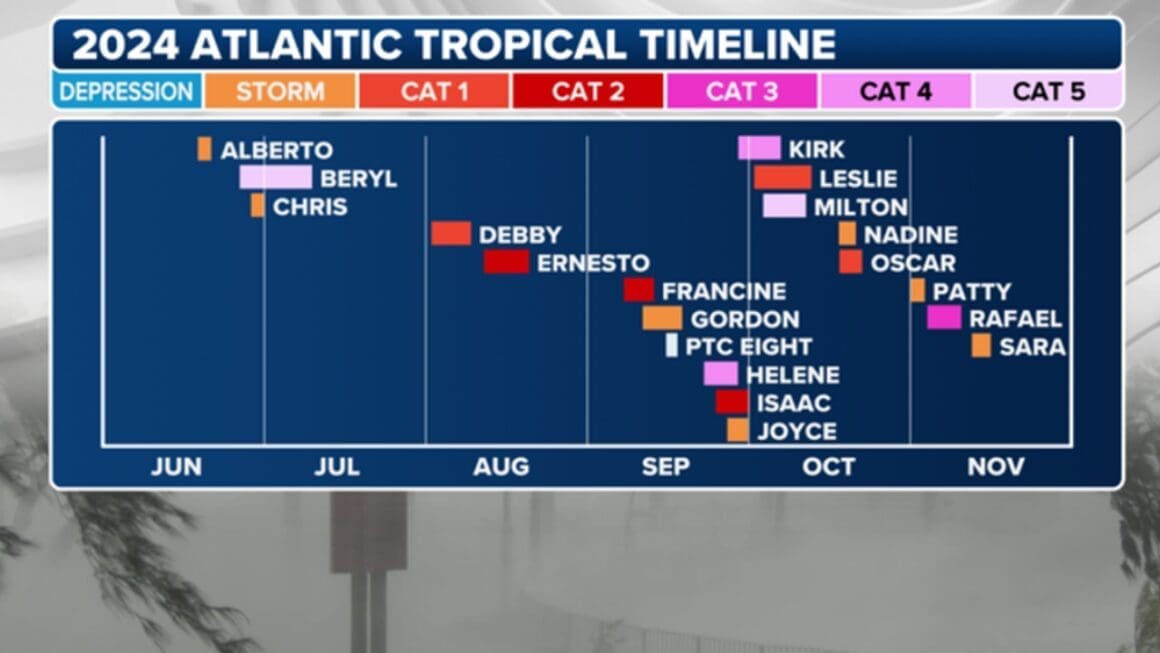As the 2024 Atlantic hurricane season concludes, it underscores its classification as a “hyperactive” year, as noted by researchers at Colorado State University (CSU). Despite falling short of forecasts for record-breaking activity, the season exceeded average levels by a significant margin.
The designation of ‘hyperactive’ arises from the season’s Accumulated Cyclone Energy (ACE), a metric reflecting the intensity and duration of tropical storms and hurricanes in the region. In 2024, the ACE value reached 162, surpassing the hyperactivity benchmark of 159.6 and exceeding the average by 23%, though it remained below the initial CSU forecast of 210, which was later adjusted to 230.
CSU initially predicted 23 named storms for the season, later increasing this expectation to 25. However, the actual count was 18, still above the typical 14-15 storms per season. “Our April and June forecasts were the most accurate across all measurements,” commented Dr. Phil Klotzbach and his team at CSU. They acknowledged that the projected increase in activity during July and August updates did not materialize, characterizing the forecasts as slightly overestimated.
An unexpected decrease in storm activity occurred midseason, affecting the accuracy of forecasts. Factors such as unusually warm Atlantic water temperatures, reduced wind shear, and record-low levels between August and October contributed to aggressive forecasting. Despite this, a midseason lull emerged due to a convergence of factors: drier air from a northward shift in African storm tracks, an unusually warm upper atmosphere, and excessive wind shear in the central Atlantic. This lull was unprecedented since 1968, with no new storms named from August 13 to September 8.
Nevertheless, the season was notably severe, with five hurricanes making landfall in the United States, including Beryl, Debby, Francine, Helene, and Milton. The latter two struck Florida within two weeks, causing extensive devastation across the state and the Southeast, resulting in over 250 deaths and approximately $200 billion in damage.
The 2024 season featured numerous significant events and observations, despite falling short of forecast numbers. The Atlantic Basin’s 11 hurricanes tied for the fifth-highest in a season, and the five hurricanes hitting U.S. shores matched years such as 1893, 2004, and 2005. Additionally, four major hurricanes formed after September 26, second only to the highest number recorded in 2020.
Historic records were set: Hurricanes Kirk and Leslie were the earliest eastward formations in October; Hurricane Beryl achieved the earliest Category 5 status and the most rapid intensification before July, with a peak wind speed of 165 mph. Hurricane Milton’s peak speed of 180 mph was the Gulf of Mexico’s strongest since 2005’s Hurricane Rita, and its pressure was the lowest since Wilma in that year. Hurricane Rafael marked only the second major hurricane forming in the Gulf during November since Hurricane Kate in 1985.
The 2024 Atlantic hurricane season stands as a significant period of meteorological activity. While it did not meet its elevated forecast expectations, it nonetheless proved to be a year of notable storms and records. The insights gained will contribute to future understanding and preparation strategies for hurricane seasons.
Source: Fox13news














